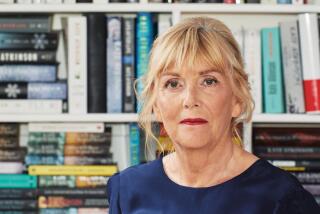Of Pride, Prejudice and Financial Troubles : Landmarks: The mistaken notion that Jane Austen’s cottage was to be sold caused an uproar. In reality, though, it was the estate’s manor house that was on the block.
CHAWTON, England — Alongside silhouettes of long-nosed women, a worn writing table and a lock of light brown hair, three signs grace the cottage where Jane Austen wrote her last novels.
“Please Note! This house has not been sold and never will be!” say the handwritten messages. Tucked between exhibits, the notes allude to family squabbles, money woes and misunderstandings to rival those from the novelist’s own pen.
Here in this tiny village not far from her birthplace, the author of “Pride and Prejudice” and “Emma” lived from 1809 to 1817 in a cottage, now a museum, loaned to her by her wealthy brother Edward.
His Elizabethan manor house, soon to be a luxury hotel and golf club, is up the road. It was the recent sale of the manor house, named Chawton House, that ruffled a lot of feathers.
“I had people ringing up in tears saying, ‘How could you close Jane Austen’s house?’ ” says Jean Bowden, the amenable curator of the novelist’s cottage. “Everybody thought it was us being sold, not the Great House.”
Bowden, a botanist, placed the signs in the museum to squelch rumors. Yet attendance rose as misinformed devotees rushed to see the museum, run by an independent trust, before it was gone.
For others, the sale last January truly caused dismay.
Henry Rice, a great-great-great grandson of the author’s niece, formed a trust last year to buy the manor and convert it into a Jane Austen research center. But he couldn’t meet the asking price of owner Richard Knight, a descendant of Edward.
Today, Rice’s search for a house in which Jane Austen “would have felt comfortable” continues, both in Chawton and beyond. And he doesn’t see much of his distant relation.
“We don’t have much to talk about; he’s gone one way and I’ve gone the other,” says Rice, a retired farmer. “He’s gone into the hotel business. . . . That’s very little to do with Jane Austen.”
The author did not spend much time at the Great House either. She liked to stroll about the splendid grounds and visit when her brother and his large family were there, but Edward mostly lived at other estates.
One of Jane’s six brothers, Edward inherited his properties from a rich benefactor, Thomas Knight. Later, Edward took the name of Knight.
Jane Austen was not rich. The daughter of a clergyman, she never married and had little pocket money until several of her books were published shortly before she died at age 42 in 1817.
The writer, with her keen observations of families and human nature, would have well understood the money woes that drove Richard Knight to sell the Great House.
“Nobody who has not been in the interior of a family can say what the difficulties of any individual of that family may be,” she wrote in 1815.
When Knight, a farmer, inherited Chawton House, he realized he couldn’t afford to repair or keep the 51-room manor, where floors sag and rain leaks into 16th-Century oak-paneled rooms.
After mulling over offers, Knight sold the house on a 125-year lease to a colorful entrepreneur, Robert Jarman, and two other local businessmen who plan to spend about $40 million to convert it into a 39-bedroom luxury hotel and golf club.
Under the agreement, after 125 years the house will be returned to the Knights, along with gardens restored to their Austen-era splendor and hundreds of acres of former estate property being re-purchased for two 18-hole golf courses.
“One hundred and twenty-five years is a long time, but in terms of 400 to 500 years in the family, it’s not so bad,” says Knight, adding that he believes Jane Austen would have found the arrangement a “jolly answer” to his difficulties.
“In a sense, we’re restoring the estate to his family,” says Jarman, a bearded man who charges enthusiastically across the grounds in his jeep to show a visitor its wild beauty and future potential.
Jarman, who calls himself a “frustrated architect,” has hired a Welsh architect famous for his restorations and the two have worked closely to try to preserve the house. One wing of bedrooms, for example, will be built into a hill.
“I don’t want to iron out any of the magic,” says Huw Thomas, the architect. “It’s rather like an Agatha Christie set.”
Gradually, their efforts to “tread carefully” won over the skeptical residents of the village, population 330, and those living nearby in the rolling hills and pastures of Hampshire.
“I had doubts about it originally, because I thought having two full golf courses in Chawton was a bit much,” says Colin Allen, who represents the village on the regional planning board.
“But after seeing how carefully it was all thought out, I changed my mind,” he says. “My views were affected by the local people. . . . They were in favor because it wasn’t going to spoil the village.”
“We’d all prefer the family to be living there,” says curator Bowden. “But the current solution is nice. It keeps the squire in the village.”
In her own practical way, perhaps Jane Austen too might have approved. She once wrote that endings shouldn’t “dwell on guilt and misery.”
“I quit such odious subjects as soon as I can,” she wrote, “impatient to restore everybody, not greatly in fault themselves, to tolerable comfort and to have done with all the rest.”
More to Read
Sign up for our Book Club newsletter
Get the latest news, events and more from the Los Angeles Times Book Club, and help us get L.A. reading and talking.
You may occasionally receive promotional content from the Los Angeles Times.







